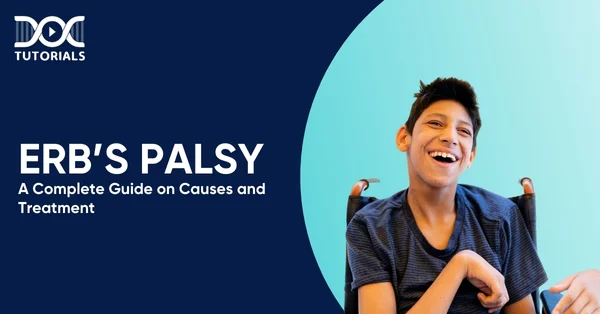Erb’s Palsy | A Complete Guide on Causes and Treatment

Erb’s palsy is a disorder that affects the brachial plexus nerve and might make your arms weak or paralysed. This disorder, also called Erb-Duchenne paralysis, frequently happens during childbirth. If it remains undetected and treatment is delayed, this injury could have long-term implications.
To deal with these kinds of medical conditions efficiently, you need to know in detail about their causes, symptoms, risk factors, diagnostic processes, and accessible therapies. Also, it will be highly useful in covering your syllabus in case you are preparing for NEET PG.
Read on to learn more about Erb’s palsy!
What is Erb’s Palsy and What are Its Types?
Erb’s palsy generally occurs in newborns after a difficult birth, although it can also impact adults after a serious injury. In this medical condition, the brachial plexus is affected. It is a group of nerves that runs from the spinal cord in the neck to the shoulder, arm, and hand, responsible for controlling sensation and muscle contraction.
Depending on the severity and the kind of nerve damage that has occurred, Erb’s palsy can be classified into four main types:
- Neuropraxia: A stretched but not torn nerve is a sign of neuropraxia. If the damage is mild, it usually goes away on its own.
- Neuroma: Scar tissue forms around the damaged nerve, making it harder for signals to go through.
- Rupture: The nerve is torn, but not at the spinal cord. Surgery is feasible for fixing this condition.
- Avulsion: The nerve is ripped off the spinal cord, and since it can’t be put back together yet, it will never function again.
What Causes Erb’s Palsy?
Trauma to the brachial plexus nerves during childbirth is the main reason for Erb’s palsy or Erb’s paralysis. This happens a lot when the baby’s shoulders are hard to get out after the head has come out (shoulder dystocia).
If too much force is applied to help deliver the baby or if the infant’s head and neck are moved to one side during birth, the nerves could be stretched, crushed, or torn.
Here are some other things that can cause Erb’s palsy:
- The baby is in the wrong place in the uterus
- Long labour
- Deliveries in the breech position
- Using forceps or a hoover to pull the baby out during birth
Adults can have Erb’s palsy in very rare circumstances when they hurt themselves in ways like falling, car accidents, or getting hurt while playing sports that stretch or tear the brachial plexus.
What are the Factors that Make Erb’s Palsy More Likely to Happen?
There are a number of factors that make it more likely for a youngster to get Erbs paralysis. Some of them are:
- Shoulder dystocia is more likely to happen to bigger babies. If a mother has diabetes, her baby is more likely to be bigger.
- Long or hard employment raises the risk of nerve damage.
- Babies born with their feet or buttocks first, often known as breech presentation, are at a higher risk.
- Using equipment like forceps or vacuum extraction to help with delivery can increase the danger.
- Women who have once had a baby with a brachial plexus injury are more likely to have another one with the same condition in the future.
What are the Symptoms of Erb’s Palsy?
Symptoms of Erb’s palsy usually show up right after delivery and can be mild to severe, depending on the extent of nerve damage. Some of the most prevalent signs are:
- Shoulder, arm, or hand weakness or paralysis
- The arm was bent at the elbow and turned inside, like a “waiter’s tip” position
- The injured hand has a weak or no grip
- Weak muscles in the upper arm
- Your arm or hand may feel tingly or numb
- Not being able to feel anything in the shoulder, arm, or hand
- The shoulder, arm, or wrist can’t move too much or at all
- Weak grip or a weaker gripping response
In mild situations, there may only be a little weakness or numbness. However, in severe cases, the arm may become completely paralysed and lose its ability to move.
How Do Doctors Diagnose Erb’s Palsy?
A full physical exam is the first step in diagnosing Erb’s palsy. This includes the following steps:
- The doctor will look at the baby’s arm movement, muscular tone, and reflexes.
- A limp arm, an unusual posture, and the Moro (startle) response not being present on the affected side are all important indicators.
To confirm the diagnosis and find out how severe the nerve damage is, clinicians may use:
- Electromyography (EMG), a test that measures the electrical activity of muscles to detect nerve damage.
- Nerve conduction studies are done to see how well electrical signals travel across the nerves.
- Magnetic Resonance Imaging (MRI) gives clear pictures of the brachial plexus and the tissues around it.
- Ultrasound can find related injuries, such as broken bones.
What are the Treatment Methods for Erb’s palsy?
The procedures for Erb’s palsy treatment depend on the severity of the injury and the patient’s age. Most babies with slight injuries get well completely without surgery. Treatment methods generally include:
- Body and Occupational Therapy
Early and persistent physical therapy is the most important part of treating Erb’s palsy:
- It involves mild massage, range-of-motion exercises, and strength training to keep joints flexible and stop muscles from getting tight.
- Occupational therapy helps kids learn how to use their afflicted arm in everyday tasks and improve their fine motor abilities.
- Splints, braces, or tape can keep your body in the right position and help it heal.
- Drugs
Pain relievers and anti-inflammatory drugs can help with pain, but they don’t fix the nerve injury that caused it.
- Electrical Stimulation of the Neuromuscular System
This method sends modest electrical currents through the muscles to get them to work, which may make the arm stronger and improve blood flow.
- Botox Treatment
Botulinum toxin injections can temporarily paralyse some muscles, allowing weaker muscles to become stronger and joints to become more flexible.
- Surgery
In very critical cases, surgery may be needed. To restore function, nerve grafts, nerve transfers, or tendon transfers can be used. If there isn’t a significant improvement after 3 to 6 months of therapy, surgery is usually the next step.
FAQs About Erb’s Palsy
- Can Erb’s palsy go away on its own?
Yes, modest cases where the nerves are just stretched (neuropraxia) generally get better on their own, especially if they get physical therapy early on.
- Can you stop Erb’s palsy from happening?
Careful obstetric control during delivery can stop a lot of cases from happening. But some risk variables, such as the size and position of the foetus, are not always under one’s control.
- What is the difference between Klumpke’s palsy and Erb’s palsy?
Klumpke’s palsy affects the lower brachial plexus, which controls the forearm, hand, and fingers. Meanwhile, Erb’s palsy affects the upper brachial plexus, which controls the shoulder and upper arm.
- What does the future hold for kids with Erb’s palsy?
Most kids get back a lot of their function after being diagnosed and treated early. But in very severe cases, if the nerve is torn or pulled apart, it could cause permanent paralysis or disability.
Conclusion
The treatment of Erb’s palsy completely depends on the severity of damage and the number of nerves affected. Quick recognition, early treatment, and a team approach can all help children recover and have a better quality of life.
Want a more in-depth analysis on this subject? Get professional help from DocTutorials. Our NEET PG course is meant to provide the best tutorials to students through video lectures, study materials, mock tests, question banks, and more. Enrol in our NEET PG courses today!
Latest Blogs
-

NEET SS Exam 2024: Analysis, Key Dates, Counselling
The NEET SS 2024 exam kicked off on March 29, 2025. Over two days and two slots, candidates across 13…
-

NEET PG Registration 2025: An Essential Guide For Exam Prep
The NEET PG registration, which is conducted online, is a crucial step in the exam process. Filling out the NEET…
-

NEET PG Syllabus 2026: A Must-Have Complete Guide for Exam Success
The NEET PG Syllabus acts as one of the foundation stones for aspiring postgraduate medical students like you who are…




